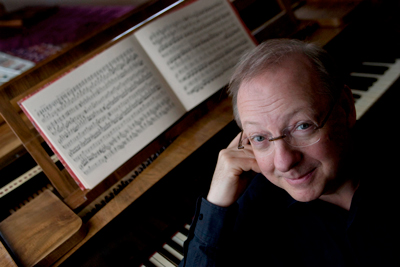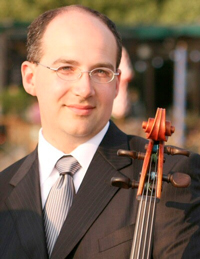by Robert Rollin

The evening’s highlight was Cleveland Orchestra principal cello Mark Kosower’s exemplary performance of Franz Joseph Haydn’s Cello Concerto in C Major.
Thought to have been lost, this beautiful and virtuosic early work was only rediscovered in 1961. Cello soloists the world over immediately took it up and, like Haydn’s D-Major concerto, it became a staple of the cello repertoire.
Kosower fairly sparkled in the first movement, Moderato, projecting a wonderful tone color in the extended opening solo passages. The more expressive and tuneful second theme was simply gorgeous. After a short recapitulation, Kosower’s long and elaborate cadenza was stunning. The challenging double stops and extensive passagework poured forth with grace and precision. Beyond the strings, the scoring included only two oboes and two horns, helping the low register solo instrument to project clearly over the accompaniment.
Haydn eliminated the wind instruments in the eloquent second movement, Adagio, allowing Kosower’s long-held opening note to stand out in relief against the moving parts. Several especially attractive dialogues between soloist and the lovely first violin section beautified the movement, as did frequent imitation among soloist and various individual orchestral sections. The solo cadenza was both short and sweet.
The Finale, Allegro molto, was full of rapid solo passagework that Kosower negotiated with extreme speed and flawless, nimble grace, eliciting thunderous applause.
MeGegan began the concert with Johann Sebastian Bach’s Orchestra Suite No. 3 in D Major, BWV 1068. As in all four of Bach’s Suites, the introductory Overture began with the dotted rhythms associated with the French Overture. Though not specified in the original score, the faster section treated some of the entrances as concertino sections, with the principal players performing the designated parts alone and making for an interesting performance. Suite No. 3 provided a wonderful excuse to display the marvelous Cleveland Orchestra trumpet section. All three trumpets — Michael Sachs, Michael Miller, and Lyle Steelman — were exceptional throughout.
The second movement, Air, known as the famous Air on the G String, was a delight. Jung-Min Amy Lee played the violin solo melody especially expressively. The third movement, containing two Gavottes, brought back the winds. The second Gavotte inverted or reversed the rhythmic pattern, from quarter followed by two eighths, to two eighths followed by a quarter, giving the conjoined two dances a lilting and catchy rhythm rounded out by the repeat of Gavotte 1.
The three trumpets and timpani increased their activity in the fourth movement, Bourrée, adding greater tonal weight to this movement and creating an interesting contrast despite the use of the same duple meter. The final movement, Gigue, continued the expanded activity of trumpets and timpani, and presented a cheerful six-eight meter with lots of sequences made all the more lively by the wide melodic leaps.
The second half of the concert began with Johann Christian Bach’s Sinfonia in G Minor, Opus 6, No. 6. Johann Christian, the last of Bach’s many children, first went to study with his elder brother, Carl Philipp Emanuel in Berlin. After considerable success in Italy in the opera genre, Johann Christian moved to London as an opera composer. He then partnered with Carl Friedrich Abel to create a new instrumental music concert series in Soho.
The G Minor Sinfonia was one of a set of six similar works written for the new series. The piece sandwiched a lovely and expressive Andante between two lively Allegros. The Andante featured many on-the-beat grace notes that added poignant dissonances. The viola section performed its many entrances with particular élan.
The closing work was Wolfgang Amadeus Mozart’s Symphony No. 31 (“Paris”) in D, K. 297. Mozart was only 22 years old and had been unable to find permanent work in Germany after leaving Salzburg. Arriving in Paris, he was clever enough to capture the Parisians’ attention by adapting his style to their musical interests.
The first movement, Allegro assai, opened with a stylishly brash unison passage followed by rocketing scale figures. Though clearly a youthful creation, Mozart’s power and brilliance emerged. He saved the horns for the energetic but conventional closing theme. The Andante was graced with lovely flute and oboe lines (played by Marisela Sager, Saeran St. Christopher, Frank Rosenwein, and Corbin Stair) and scintillated with fine accentuation and nuance. The Finale was a contrapuntal delight, with overlapping entrances in the fugatos, and exciting rapid sixteenth-note passages that surged to an exciting conclusion. MeGegan held things together enthusiastically and partnered with the ensemble to create a brilliant performance.
Published on ClevelandClassical.com August 25, 2015.
Click here for a printable copy of this article




